Please Take Note: This is a review of the final game, but it might change slightly based on the success of the Kickstarter campaign. The game is being reviewed on the components and the rules provided with the understanding that “what you see is not what you might get” when the game is published. If you like what you read and want to learn more, we encourage you to visit the game publisher’s website or visit the Kickstarter campaign. Now that we have all that disclaimer junk out of the way, on with the review.

The Basics:
- For ages 7 and up (publisher suggests 8+)
- For 2 to 5 players
- Variable game length (approximately 30 minutes per player)
Geek Skills:
- Counting & Math
- Logical & Critical Decision Making
- Reading
- Pattern/Color Matching
- Strategy & Tactics
- Risk vs. Reward
- Hand/Resource Management
Learning Curve:
- Child – Easy
- Adult – Easy
Theme & Narrative:
- Risk the treacherous high seas to make a huge profit
Endorsements:
- Gamer Geek rejected!
- Parent Geek approved!
- Child Geek approved!
Overview
American writer George William Curtis said, “It is not the ship so much as the skillful sailing that assures the prosperous voyage.” In this game, players will command a fleet of ships that will traverse the Atlantic ocean in search of goods to buy and sell for profit. But the journey is treacherous, filled with pirates and cutthroat competition. Skillful sailing will win the day, but so will cannon fire.
Cargo: Dead in the Water, designed by Chad Kosokowsky, David Molesky, and to be published by Cheese Block Games, will reportedly be comprised of 1 game board, 15 Ship miniatures, 2 standard six-sided dice, 36 Cargo pieces, 5 Score tokens, 9 Market tokens, 6 Dead in the Water tokens, and 102 cards. As this is a review of a prepublished game, I will not comment on the game component quality. The game’s artists, Brigid Ward and David Molesky, have visually provided the players a game that matches its theme perfectly. Colorful and welcoming, the game’s presentation drew our players to the table before they even knew what the game was about.
At the Docks
To set up the game, first place the game board in the middle of the playing area. Players should take a moment to familiarize themselves with the game board. Note the compass rose in the middle, as cardinal direction does play a role in the game.
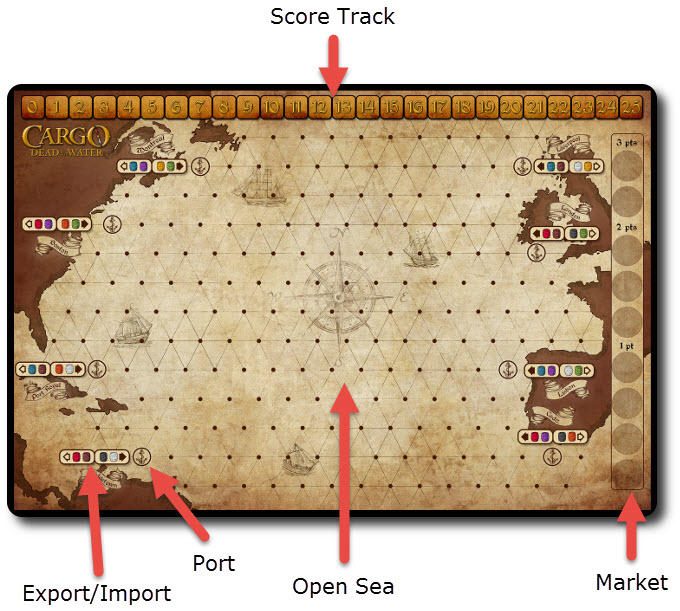
Second, take the 9 Market tokens, place them face-down, and then shuffle them. Then randomly select 4 Market tokens and flip them over. The Cargo types shown will be worth 1 victory point each. Place these on the Market track under the “1 pt” heading.
Third, reveal another 3 Market tokens. The Cargo types shown will be worth 2 victory points each. Place these on the Market track under the “2 pts” heading.
Fourth, reveal the last 2 Market tokens. The Cargo types shown will be worth 3 victory points each. Place these on the Market track under the “3 pts” heading.
Fifth, have each player select the color for their fleet of ships. In a 2 and 3-player game, each player will collect 3 Ship miniatures. In a 4 and 5-player game, each player will collect 2 Ship miniatures.
Sixth, take the cards and shuffle to create 1 deck. Deal 5 cards to each player, face-down. This is the player’s starting hand. Place the deck to one side of the game board, face-down. This is the draw deck for the duration of the game. Leave room for a discard pile.
Seventh, determine who will be the first player by having each player roll one of the six-sided dice. The player who rolls the highest is the first player. Re-roll for ties.
Eighth, starting with the first player and continuing in turn order sequence, players now place their Ship miniatures on the game board. After the first player places 1 ship, the next player places 1 ship and so on until all players have placed their Ship miniatures in ports. Players must place their Ship miniatures in empty ports if possible. Once all the ports have at least 1 Ship miniature, then players can place additional Ship miniatures at the same ports.
Ninth, set the dice, Cargo pieces, Score tokens, and Dead in the Water tokens to one side of the game board in separate piles to create a general supply.
That’s it for game set up. Time to set sail!
A Quick Look at the Ships and Cards
Each ship in the player’s fleet is capable of moving goods across the ocean, but the amount of goods to be sailed from one port to another is limited. The Cargo pieces are literally carried on the deck of the Ship miniatures. Two at the stern and one at the bow. There are no restrictions on cargo types, meaning the player could hold 3 Cargo pieces of the same color or 3 Cargo pieces of different colors.
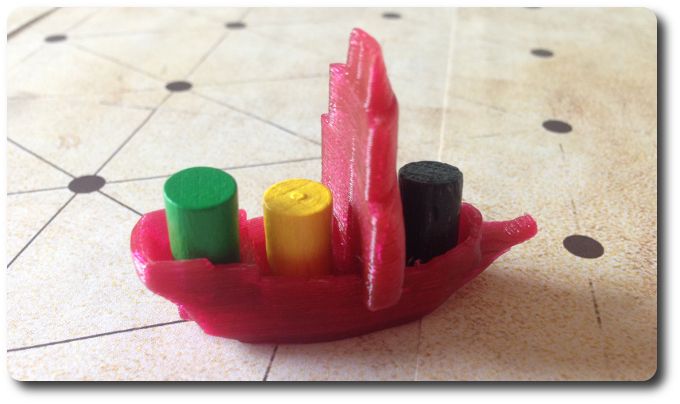
At a glance, a player can quickly determine how much cargo their ships have, of what type, and how many victory points the cargo is worth by matching the Cargo piece colors with the Market tokens. This makes managing the logistics of sending the ships around the world fairly easy. However, this same information is available to opponents, meaning a player’s opponent knows exactly which ship is the wealthiest at sea.
Cargo Cards
The Cargo cards allow the player to export goods and materials while in port. The Cargo card must match the Cargo piece to be exported. The Cargo cards provide the names of the ports where the specific goods noted on the card can be found. The Cargo card also provides the names of the ports where the Cargo pieces can be taken and imported to score points.

But cards are not enough. Location is also important. Players must anchor their Ship miniature at a port that specifically exports the noted goods on the Cargo card if it’s to be placed on the Ship miniature. Likewise, the Ship miniature must be located at a specific port that imports the same noted goods if it’s to be taken off the Ship miniature and score points. The game board makes it visually clear what each port is looking to send and to receive. Arrows that point to the open sea are exports (goods to be shipped) and arrows that point away from the open sea are imports (goods to be taken from ships). Depending on which side of the Atlantic ocean a player’s ship is located, the arrows will point differently.
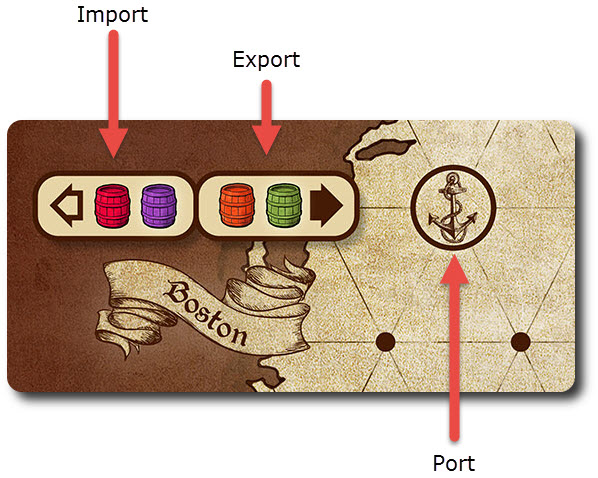
Adjust the Market Cards
The market and demand for goods fluctuates during the game, but only if the players want it to. This could be in the player’s favor or not. For example, a piece of cargo picked up in port could be worth a great deal, but once the same cargo is exported, it could be nearly worthless due to a shift in the market. The Adjust the Market cards allow the player to manipulate the market prices. However, there is risk. The adjustment could make things worse or not have any impact at all.
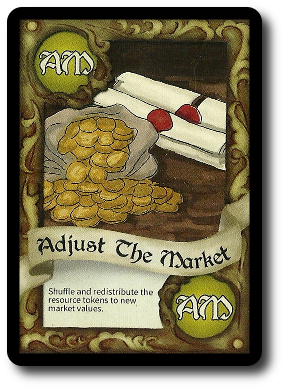
Wind Cards
The Wind cards give captains a bit more speed at sea and the player bonus Ship miniature movement. The wind, however, is a neutral party and cares not which sail catches it. A player can use their Wind cards on their own ships or on their opponents. The wind is also fickle about in what direction it blows. Wind cards will only give a bonus to ships that move directly east or west. Additionally, ships that are dead in the water cannot be effected by the wind and remain motionless on the rolling ocean waters.
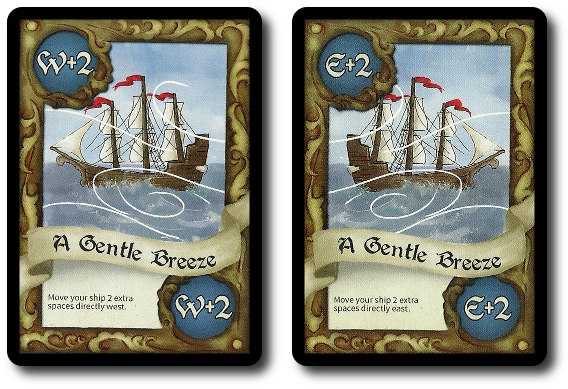
Battle Cards
Merchants are cutthroat businessmen and women. At sea, they are even worse. During the game, players can come across an opponent’s ship. At which time, they can either pass quietly or engage each other in battle. The Battle cards are used to help increase the odds of winning the skirmish versus being sunk below the icy waves. They can also be used to cowardly run from the battle.
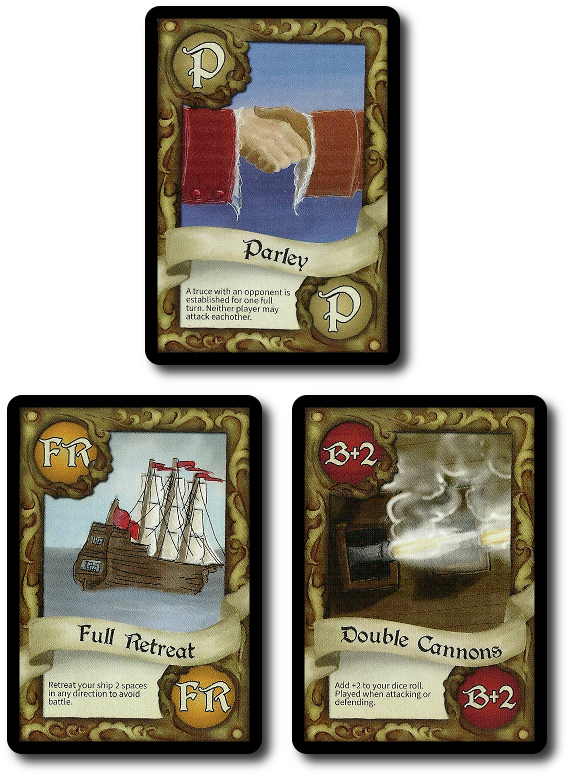
Pirate Cards
The Pirate cards represent the roving marauders who hunt ships like wolves hunt fat sheep. Pirate cards are played on a player’s turn to slow down opponents who have Ship miniatures out at sea. This initiates a battle wherein the player represents the pirates but does not actually join the skirmish. Unlike a true battle that is played out during a player’s turn directly against another opponent, attacked ships cannot play Battle cards to improve their odds of success. Truly, being attacked by a pirate crew is a harrowing experience!
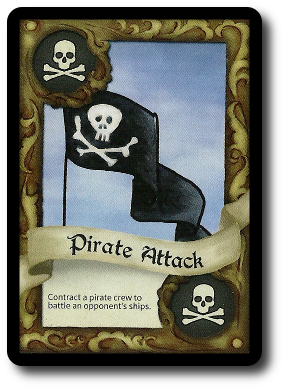
Tempting Fate, Chasing Fortune
Cargo: Dead in the Water is played in turns with no set number of turns per game. A player’s turn is summarized here.
Phase 1: Draw Cards
The first action the player takes on their turn is drawing 2 cards from the draw deck. These are added to the player’s hand and can be used on the player’s turn or kept for later. If the draw deck is depleted, shuffle the discard pile to create a new draw deck.
Phase 2: Navigating the Open Sea
The second phase is a good deal more involved than the first. Three possible actions are available to the player and they can be taken as many times as possible and in any order. Each of the actions are summarized here in no particular order of importance.
Play Cards
Any card in the player’s hand can be played where applicable. When played, the card is discarded.
- Play a Cargo card to export 1 specific good if the Ship miniature is at a specific port of call.
- Play an Adjust the Market card to randomize or subtly shift the market.
- Play a Wind card to improve Ship miniature movement or hinder an opponent.
- Play a Pirate card to hinder an opponent’s ship that is not located in a port.
The only card type that cannot be played during this step is the Battle card. These are reserved for battles later in the player’s turn.
Move Ships
Each Ship miniature in the player’s fleet can move up to 5 dots during the player’s turn. Additional dots can be moved with the help of Wind cards. All movement is done by moving a Ship miniature from one dot to another dot that is connected via a line.
Each dot can only have 1 Ship miniature at a time and Ship miniatures cannot pass through a dot already occupied by another Ship miniature. The one exception are ports which can hold countless ships without restriction.
While Ship miniatures cannot occupy the same dot in the open sea, they can be adjacent to each other. If 2 Ship miniatures are, Cargo pieces can be transferred from one Ship miniature to another as long as there is space for the Cargo piece.
The only Ship miniatures that cannot move are those currently under the effects of being “Dead in the Water”. However, Cargo pieces can still be transferred.
Score Points
If the player imports (removes Cargo pieces) goods at a port, they remove the Cargo piece and return it to the general supply. They then score a number of victory points equal to the Cargo piece’s current worth on the market. The player adds their victory points to any others they might have earned by moving their Score token accordingly. Unloading a ship does not require a card and the player can offload as many Cargo pieces as they like, but only if the port is importing cargo that matches that player’s Cargo pieces. If not, the player will have to find another port to offload their goods.
Phase 3: Battle
After taking as many actions as the player likes during the previous phase, the player MUST attack an opponent’s ship if they are adjacent to each other at sea. Ships located in ports are safe from pirates and all attacks. The easiest way to summarize a battle is by simply breaking it down into numerical steps.
Step 1: Play Battle Cards
The opponent (the player being attacked) is allowed to play 1 Battle card from their hand, which they place face-up in front of them. Then the player attacking does the same. Playing a Battle card is always optional. In summary the possible effects of the Battle cards will influence the skirmish as follows:
- A truce is arranged and both captains and their ships go their own way in peace.
- A full retreat is ordered by the opponent’s captain that allows them to move their Ship miniature out of harms ways.
- A cowardly retreat is ordered by the opponent’s captain that allows them to move their Ship miniature even further, but at a price. 1 Cargo piece must be removed and returned to the general supply.
- Both players attack each other with cannons that provide a combat bonus.
Step 2: Roll Dice
Each player, the attacker and the defender, now roll a single six-sided die. The resulting rolled value, plus any bonuses provided by Battle cards, is the player’s “Battle Score”. Rolling for a Battle Score is only necessary if a skirmish ensues. If the defending player is able to successfully parlay or runs, no battle between the two ships will occur.
Both players now compare their Battle Scores. The player with the higher Battle Score is the winner. Calculate the differential between the two scores. For example, the differential between Player A’s Battle Score of 5 and Player B’s Battle Score of 2 is “3”.
Step 3: Collect Cargo
The player who lost the battle must now give a number of Cargo piece to their opponent equal to the Battle Score differential. The opponent who won the battle can choose any Cargo pieces they like. Since each Ship miniature can only hold 3 Cargo pieces, a Battle Score differential that is higher than 3 is treated as 3 without bonuses. If the player likes, they can return currently held Cargo pieces to the general supply to make room for new cargo. The player can also elect to simply take their opponent’s Cargo pieces and return them to the general supply. Essentially, tossing the goods overboard.
Step 4: Dead in the Water
Things continue to get worse for the player who lost the skirmish at sea. The losing player now takes a Dead in the Water token and places it underneath or by their Ship miniature. This indicates that the ship is in need of repair and cannot move. However, being dead in the water affords the player some protection. Any Ship miniature that currently has the Dead in the Water token cannot be attacked or be the target of any cards, including Pirate cards.
Step 5: Even More Battles
The player continues to resolve all the battles they are a part of. If there are more than one, the player can decide in which order they will be resolved. This includes battles where the player’s ship is between 2 opponent’s ships. Both ships must be engaged in battle, meaning a player’s ship could be part of 2 battles in a single turn unless it ends up being dead in the water.
The same goes for the player if they have 2 of their Ship miniatures adjacent to 1 opponent’s Ship miniature. The player must determine which ship will engaged first. If the first ship loses, the player must engage the opponent with their second ship.
Phase 4: Repair Ships
Finally, at the very end of the player’s turn, they can repair their ships that have taken damage through battles with opponents or from pirate attacks. Any ship that has the Dead in the Water token is now repaired and the token removed, which one exception. Ship miniatures that lost battles this round keep their Dead in the Water token until the player’s next turn. In this way, damaged ships are out for an entire turn, greatly hindering the player’s ability to transfer goods.
This ends the player’s turn. The next player in turn order sequence now goes starting with phase 1 noted above.
Dropping Anchor and Ending the Game
The game continues as described above, with players taking turns and shipping goods across the Atlantic ocean. When a player scores 25 or more victory points during phase 2, the game immediately ends and the player is declared the winner. Optionally, when playing a 3 to 5-player game, the winner may remove their Ship miniatures and the remaining players can continue, competing for second place.
House Rules
Our players came up with a few house rules that they felt improved the game. Like all house rules, these are not to be considered part of the game’s official rule set, but you are most welcome to use and modify them if you like.
More Dangerous Battles
Battles at sea are quick and oftentimes expensive. The only aspect of the battle most of the player’s didn’t care for was the initial open of Battle cards. The rules state the defending player plays their Battle card first and face-up. Then the attacker plays their Battle card. This was meant to mimic a real naval battle, where the defender would see the attacker coming and have time to prepare while the attacker focused fully on catching their target and reacting to new combat conditions. However, our players felt that this reduced some of the excitement and instead had both attacker and defender play their Battle cards at the same time, face-down. Once both cards were placed, they were reveal and resolved. The defender’s card was resolved first followed by the attackers. In this way, the players had no real idea what to expect until it was too late. This created an excellent level of tension and made most players think twice about attacking an opponent if they didn’t have strong Battle cards.
Floating Cargo
When a player attacks an opponent’s ship in the open sea, Cargo pieces can be moved from one ship to another. If a Ship miniature is already full, the player has the option of dumping the Cargo pieces to make room for others. The rules state that these Cargo pieces are returned to the general supply, but our players thought the Cargo pieces should remain on the space where they were dumped for 1 full game round. If a Ship miniature ended their turn on the same space as the Cargo pieces, the player could pick them up. If the Cargo pieces were still in the water after a full round of game play, they were removed and placed back in the general supply.
To learn more about Cargo: Dead in the Water, visit the game publisher’s website or visit the Kickstarter campaign.
Final Word
The Child Geeks were quickly caught up by the game’s thematic elements and took to picking up goods and fighting pirates with a smile. According to one Child Geek, “I like how you can be a pirate or not a pirate in the same game!” The Child Geeks made good use of combat, but not to a point where observes felt that the Child Geeks were doing it for any other reason than they could. Put another way, the Child Geeks fought each other on the high seas because the opportunity was there, not because they were being tactical or working towards a larger strategy. Which, let’s be honest, is perfectly fine. The goal is to be challenged and have fun, which the Child Geeks were. Another Child Geek said, “The hardest part of this game is not wasting time. You need to get your boats to where they need to be, pick up the goods, and then race as fast as you can to get points before the market changes.” An excellent summary of the game’s challenge. When all the goods were delivered, the Child Geeks voted to approve Cargo.
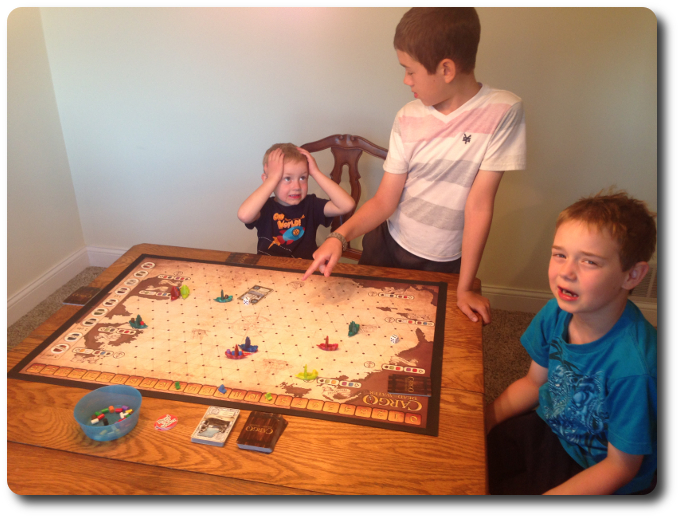
My oldest and youngest Child Geeks argue over their next move while their brother grows impatient…
The Parent Geeks were also delighted with the game. Even the non-gamers were enjoying themselves, finding the game play to be engaging and intuitive. According to one non-gamer Parent Geek, “I thought this game was going to be much more difficult with the market and collecting the right items to sell, but the real challenge is finding the best path. I like that. Feels like I’m in a race.” Another Parent Geek said, “This is a great game. I can play it with my kids, with my friends, and best of all, it’s actually more fun with a diverse group of players. I’m really enjoying this.” The only aspect of the game the Parent Geeks didn’t care for were the pirates. They preferred it when players fought against each other directly. Made it feel more “personal”, they suggested. When pirates attacked, it was just a card that was thrown. When a player attacked another player, it was an event everyone leaned in to watch. When the last cannon was fired, the Parent Geeks all voted to approve Cargo.
Frankly put, the Gamer Geeks were disappointed with Cargo. According to one Gamer Geek, “I think this game has a lot of promise and can be a deeper game than what it is today. I feel like all I am doing is picking up a block and moving it across the board. There is no real market manipulation and I don’t feel any motivation to risk anything.” Another Gamer Geek, “While I know it is obvious, the game play is all about making points. And that’s it. I don’t feel like I’m working the market, attacking at sea to make a profit, or working through a logistical puzzle to find the best profitable solution. It just feels hollow to me.” Not all the Gamer Geeks were so critical, however. One Gamer Geek said, “I think this is a great gateway game. It challenges the player to think through their moves, think ahead, and be ready to change their plans when an opportunity presents itself. This is the kind of game I wish I had growing up.” Another supportive Gamer Geek said, “A fantastic game for the family, my kids, and my non-gamer friends, but not for me. I want more to think about, more to do, and – well – just more. For what it is, I think it’s fine. But for a gaming elitist, I think it falls flat.” When all the ships were anchored, the Gamer Geeks collectively agreed that Cargo was a game worth playing for the non-gamers, younger players, and families, but not a game for the elitists.
As a Parent Geek, I really enjoyed Cargo. I found its game play to be just deep enough to keep my interested and the challenge of navigating the open sea as fast as I could to be a good logical exercise. I thought combat between players was a neat touch. It let me play as a pirate or a merchant, giving me the option to collect goods at port or at sea. A risky venture, but it gave the players an alternative that kept things interesting and offered players a choice: take the safe long route or the risky short route. I preferred to do both, having one ship play as a pirate and another run goods from port to port.
As a Gamer Geek, I found Cargo to be lacking a number of elements that I thought could easily be incorporated. Their absence made the game feel shallow at times and some of the game play largely unnecessary. My biggest disappointment was the market. I didn’t like the fact that it remained static until someone randomly redistributed the goods to different values. I didn’t like that I was able to purchase goods for free and get points for free by just dropping them off. In short, I wanted a real economy. I wanted to see prices fluctuate, ports request and offer new goods, and make a simple barrel of sugar suddenly be worth as much as gold. This type or robust market is not in the game and most likely by design. Having such a market would make the game much more complicated. Does the lack of such a robust market make the game a bad one? Certainly not, but it did reduce the level of fun for me.
Overall, I am pleased with Cargo: Dead in the Water. I found the game play simple and the amount of challenge to be perfect for families, casual gamers, and non-gamers. Players do have to put some thought into their moves, but are not overly penalized if they don’t think it fully through. Players have time to experiment a bit, but not a lot of time. When points start adding up on the Score track, it’s obvious which Ship miniatures will start getting attacked and which players need to focus in if they hope to win. The end result is a game that is light, plays smoothly, and won’t tax a player’s brain. If you think Cargo: Dead in the Water sounds like a game you’d like to try, please do so. It might not float your boat if you are a gaming elitists, but I believe most individuals will find the game seaworthy.
This is a paid for review of the game’s final prototype. Although our time and focus was financially compensated, our words are our own. We’d need at least 10 million dollars before we started saying what other people wanted. Such is the statuesque and legendary integrity of Father Geek which cannot be bought except by those who own their own private islands and small countries.




Thanks for the review Cyrus. Your review is very comprehensive, and very accurate. You really hit the nail on the head when you called our game a gateway game. That is definitely what we set out to create, so I can understand why some of the elitist gamers wished their was a bit more depth. I loved your house rule of dropping the extra cargo in the ocean. I will play test that myself, and maybe get it into the actual manufactured instructions. I think our game really does have mass appeal, but right now the work is getting it out to as many people as possible, so thank you for assisting us with that.
It was my pleasure, Chad!